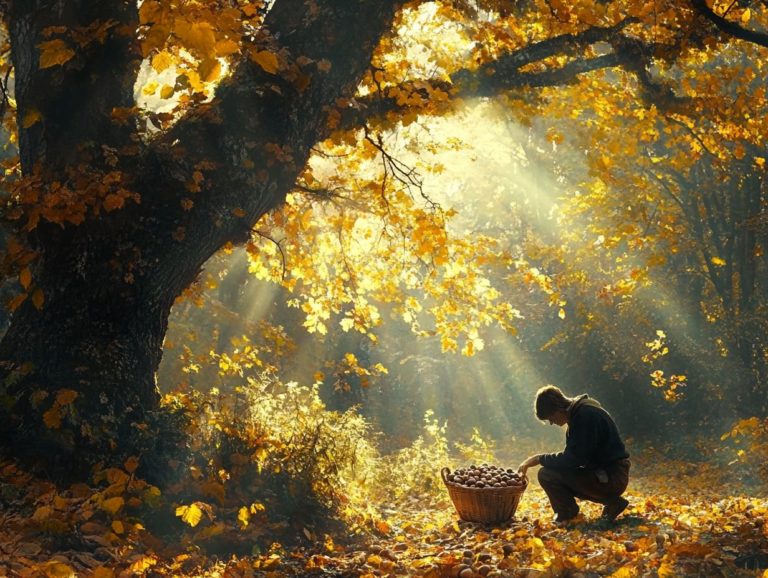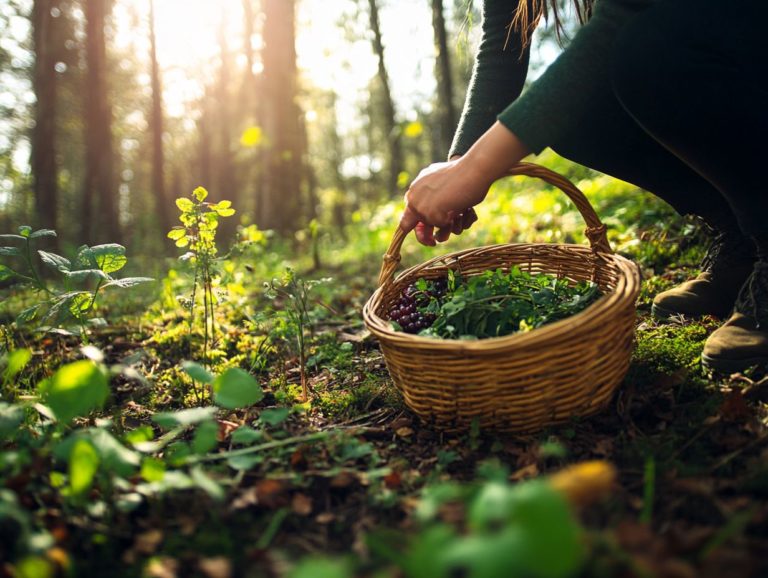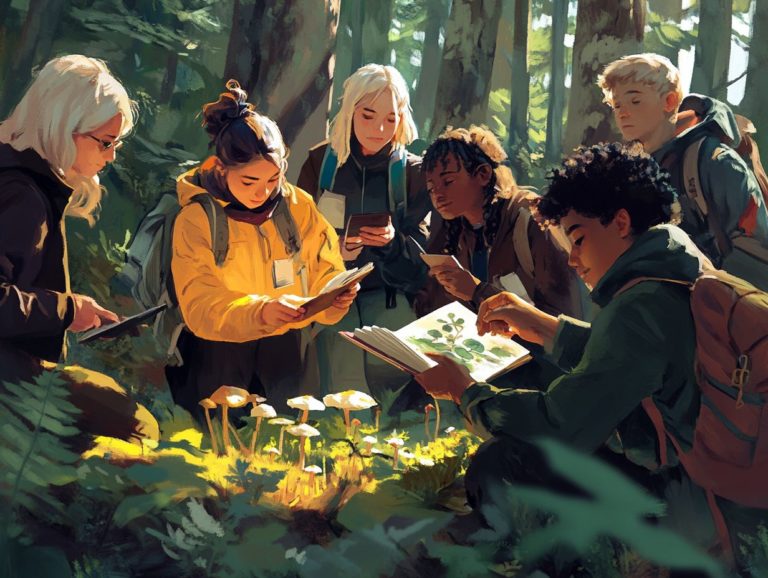The Impact of Foraging Techniques on Biodiversity
Biodiversity is the intricate web of life that sustains our planet. It is both a treasure and a delicate ecosystem.
As you explore the relationship between foraging practices and biodiversity, you will uncover a spectrum of techniques that can have profound effects both beneficial and detrimental.
Dive in as we explore various foraging methods, showcasing real-world case studies and discussing sustainable practices that help conserve natural resources.
Explore the exciting challenges and future possibilities of foraging in our ever-changing world!
Contents
- Key Takeaways:
- The Importance of Biodiversity
- Foraging Techniques and Their Effects on Biodiversity
- Case Studies: Examining the Effects of Foraging Techniques on Biodiversity
- Sustainable Foraging Practices for Biodiversity Conservation
- Future Implications and Challenges
- Frequently Asked Questions
- 1. What is biodiversity and why is it important?
- 2. How do foraging techniques impact biodiversity?
- 3. What are some examples of foraging techniques and their impact on biodiversity?
- 4. How can sustainable foraging techniques help preserve biodiversity?
- 5. What are the consequences of using unsustainable foraging techniques?
- 6. What can be done to mitigate the negative impact of foraging techniques on biodiversity?
Key Takeaways:
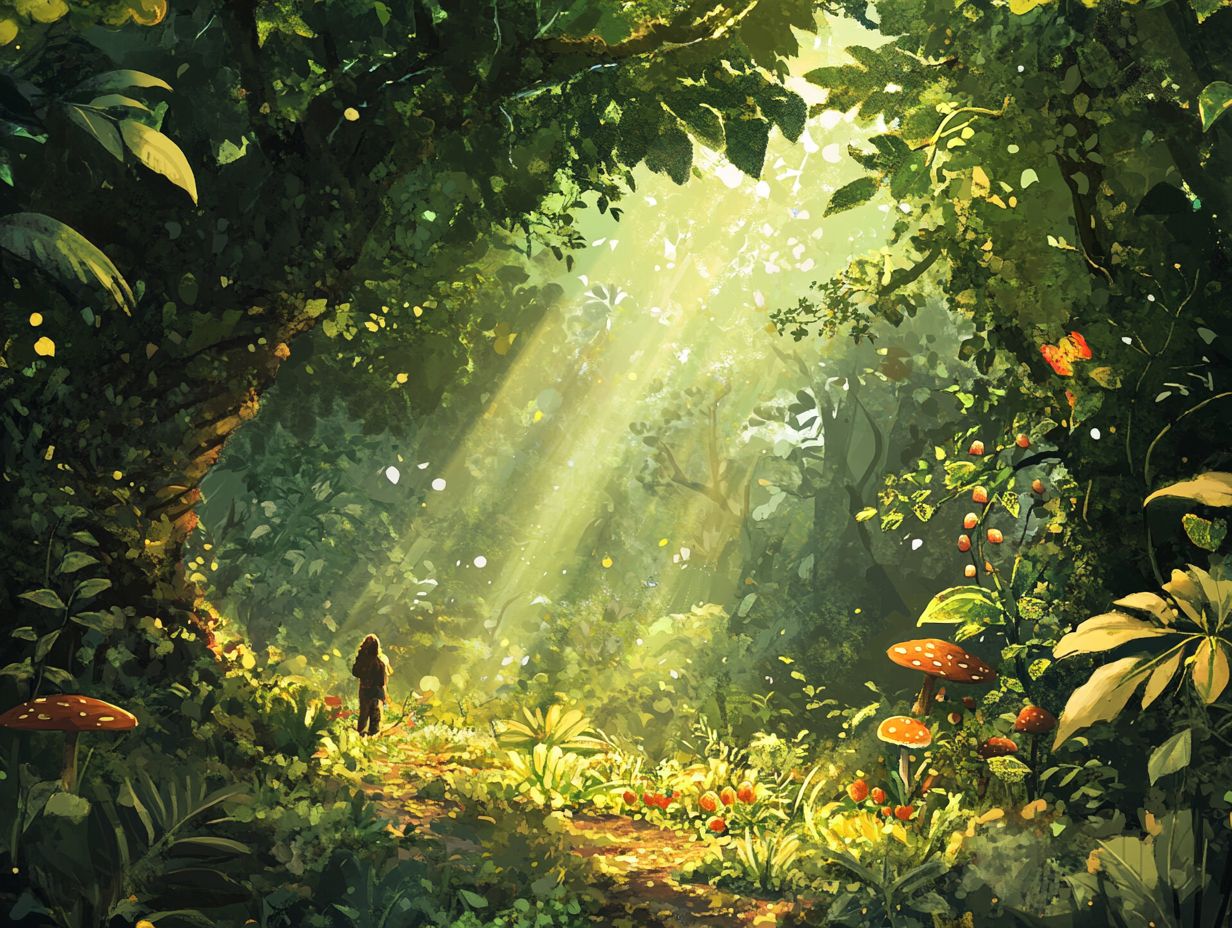
Biodiversity is essential for a healthy ecosystem.
Foraging techniques can positively or negatively impact biodiversity.
Implementing sustainable practices and government policies is crucial to protect biodiversity.
The Importance of Biodiversity
Biodiversity plays an essential role in ecological systems, including many different kinds of living things and the intricate interactions that occur within their habitats. This diversity is vital for maintaining the ecological balance necessary for both human existence and the environment.
When biodiversity declines, it can trigger species extinction, disrupt food systems, and undermine the very philosophy of conservation aimed at preserving healthy ecosystems. This challenge becomes even more pronounced as urbanized land expands, driven by climate change and the dynamics of a capitalist system.
Definition and Significance
Biodiversity includes all kinds of living things, like plants and animals, and their roles in keeping nature balanced. This intricate tapestry of life can be understood through three key components:
- Species diversity: This refers to the countless plants, animals, and microorganisms.
- Genetic diversity: This emphasizes variations within species that foster adaptability and resilience.
- Ecosystem diversity: This represents the array of habitats that nurture different communities.
Grasping the concept of biodiversity is essential, as it directly impacts food security by ensuring a diverse selection of crops and livestock is available for consumption.
Local communities gain immensely from this diversity through sustainable harvesting and preservation practices. These efforts help reduce the negative impacts of human activities on the environment and promote greater sustainability for future generations.
Foraging Techniques and Their Effects on Biodiversity
Foraging techniques encompass a range of methods used to gather wild and edible plants, highlighting the role of foraging techniques in sustainability and playing a crucial role in enhancing biodiversity.
By embracing these practices, you contribute to sustainable resource management, enriching the availability of resources within your local ecosystems. This fosters community engagement and supports the delicate balance of nature.
Overview of Different Foraging Methods
Different foraging methods, like wildcrafting, permaculture, and gathering from food forests, present sustainable ways to harvest wild plants while revealing delightful edible treasures hidden within diverse ecosystems.
Engaging in these practices deepens your connection to nature and cultivates ecological awareness. By embracing foraging techniques, you can significantly enhance local biodiversity, creating a ripple effect that benefits both native species and their habitats.
For instance, permaculture invites you to integrate edible native plants, fostering a symbiotic relationship that curbs the advance of invasive species. Food forests, by their very design, nurture a vibrant array of flora, establishing habitats that support a wealth of wildlife, including essential pollinators.
This holistic approach to foraging can lead you to healthier ecosystems while also providing you with nutritious food options.
Positive and Negative Impacts on Biodiversity

Foraging can significantly influence biodiversity, offering both benefits and drawbacks.
Sustainable foraging helps nature stay healthy and aligns with the conservation philosophy of preserving native species.
On the other hand, irresponsible harvesting practices can lead to habitat alteration and facilitate the spread of harmful plants and animals.
This duality underscores the importance of a mindful approach when gathering wild edibles. For example, harvesting wild mushrooms in moderation can enhance local populations by encouraging their spread.
However, over-collection risks a decline in their numbers.
When you focus on foraging harmful plants, such as garlic mustard, you actively help reduce competition for native flora, resulting in a positive ecological impact.
However, failing to consider the ecological context can lead to adverse outcomes, including soil erosion and the disruption of wildlife habitats.
By embracing sustainable foraging practices like rotating gathering sites and following local regulations you can quickly minimize these risks!
Case Studies: Examining the Effects of Foraging Techniques on Biodiversity
Case studies that delve into foraging techniques and their impact on biodiversity uncover essential insights into the environmental impacts of foraging and how diverse ecosystems adapt and flourish through sustainable practices.
They also highlight the challenges that arise when these practices are overlooked, providing a clear understanding of the delicate balance within our natural environments.
Examples from Different Ecosystems
Examples from various ecosystems, such as temperate forests, grasslands, and wetlands, vividly illustrate how localized foraging practices can significantly enhance biodiversity.
At the same time, they underscore the potential risks of habitat alteration.
Take temperate forests, for instance. When you gather wild mushrooms and berries, you not only indulge in delicious foraged foods but also foster awareness and preservation of native plant species.
In the grasslands, as you explore and collect edible plants, you contribute to your own sustenance and the ecosystem’s diversity by encouraging seed dispersal.
However, it s crucial to remain mindful of habitat preservation; overharvesting certain species can disrupt local populations.
Consider the wetlands: in some regions, the collection of specific aquatic plants has threatened habitats essential for local wildlife.
This serves as a reminder of the delicate balance that must be maintained between the benefits of foraging and the integrity of the environment.
Sustainable Foraging Practices for Biodiversity Conservation
Engaging in sustainable foraging practices is vital for conserving biodiversity. These techniques not only respect ecological systems but also highlight the role of foraging techniques in food security for communities that depend on wild resources.
By doing so, you can effectively bridge the gap between fulfilling human needs and preserving the integrity of nature.
Implementing Sustainable Methods
Implementing sustainable foraging methods requires you to collaborate with local communities, educate yourself on wild products, and adhere to guidelines that prioritize the preservation of native species.
This approach not only fosters a sense of stewardship among residents but also encourages the sharing of knowledge about local ecosystems.
For instance, you might consider organizing community workshops to learn about identifying edible plants and fungi.
This not only promotes responsible gathering but also strengthens the bonds within your community.
Successful initiatives, like urban foraging groups in cities such as Portland and San Francisco, illustrate how collective efforts can regenerate local flora while providing sustainably sourced food options.
By creating a culture of respect for nature and engaging in educational outreach, you can help your community thrive while ensuring that wild resources are responsibly gathered for future generations.
Join a local group today!
The Role of Government and Policies

Government policies play a crucial role in promoting sustainable foraging that helps protect our plant and animal life. By ensuring regulations protect native species while addressing challenges posed by invasive ones, you contribute to a balanced ecosystem.
When authorities implement comprehensive guidelines, they create an environment where you can forage responsibly and harmoniously with nature. Community-led programs show the value of government support in nurturing educational efforts surrounding sustainable harvesting techniques.
These initiatives elevate ecological awareness and encourage community involvement, sparking a collective commitment to preserving local ecosystems. In countries like Finland and Italy, government-backed foraging festivals have emerged as vibrant platforms for knowledge exchange.
This demonstrates how thoughtful policy interventions can profoundly influence both biodiversity conservation and community engagement, benefiting everyone involved. These festivals also showcase the environmental benefits of foraging practices and the need to connect with our human nature to foster a preservation mentality.
Future Implications and Challenges
The future implications for biodiversity linked to foraging techniques reveal a landscape rich with both opportunities and challenges. To navigate these complexities, understanding the ecosystem impact of foraging becomes essential, especially as climate change reshapes ecosystems and impacts food production. It is crucial for you to adopt flexible approaches that change based on new conditions.
These efforts are crucial for ensuring long-term ecological health and resilience. They help promote species coexistence and protect native species.
Predicted Changes in Biodiversity due to Foraging Techniques
Predicted changes in biodiversity due to foraging techniques highlight your need for adaptive management strategies that respond to climate change’s effects on ecological systems and the viability of wild plants. Understanding the interplay of nature and foraging techniques is also important.
As climate patterns shift, you will likely find that foraging calls for a heightened awareness of these ecological changes. With rising temperatures and altering precipitation patterns, the availability of certain plant species may become inconsistent.
This could prompt you to explore more sustainable and diverse options like food forests. Understanding these changes is key. You need to adapt your foraging techniques to keep up.
Embracing responsible harvesting methods that prioritize the regeneration of plant populations is essential. This approach will help maintain ecological balance and ensure that cultural traditions tied to foraging can flourish amid environmental change, promoting a healthier food web model.
Addressing Challenges for Sustainable Foraging
Addressing the challenges of sustainable foraging requires proactive community engagement, along with education and collaboration. This fosters a deeper understanding of ecological systems and highlights the importance of preserving biodiversity and environmental sustainability.
As you embrace foraging, you may encounter hurdles such as overharvesting, habitat destruction, and misidentification of edible plants. Organizing workshops and local foraging groups is crucial. These groups teach plant identification and seasonal harvest practices, while also underscoring the significance of sustainable methods and their impact on community biodiversity.
Through shared knowledge and a sense of responsibility, you and your community can develop guidelines to protect local ecosystems. This ensures that foragers become informed and respectful stewards of nature. By nurturing this collective mindset especially regarding food waste and available nutritional food your community is more likely to thrive and continue these sustainable practices.
Frequently Asked Questions
1. What is biodiversity and why is it important?
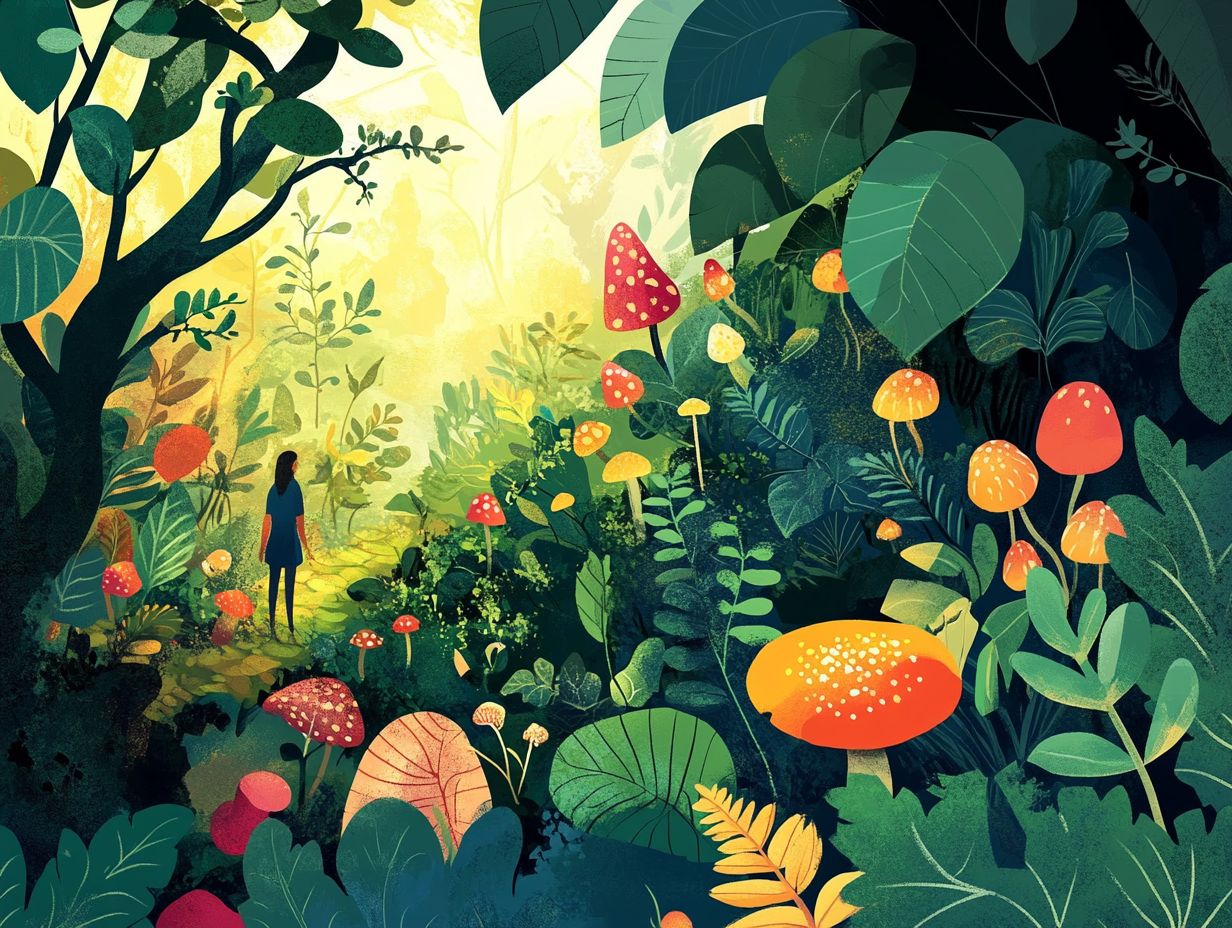
Biodiversity refers to the variety of plant and animal species, including native species and invasive species, in a particular ecosystem. Biodiversity is vital! It boosts our environment s health and stability, providing essential services like nutrient cycling and pollination while supporting food security.
2. How do foraging techniques impact biodiversity?
Foraging techniques significantly impact biodiversity as they determine how animals obtain food. Depending on the method, certain plant and animal species may be overused, leading to population declines and disrupting ecosystem balance. Understanding the impact of foraging on biodiversity is crucial, especially through toxic practices that harm native wildlife.
3. What are some examples of foraging techniques and their impact on biodiversity?
Examples include grazing, browsing, and scavenging. Grazing by large herbivores can reduce the diversity of plant species. Browsing by smaller herbivores can lead to overgrazing, negatively affecting plant populations. Scavenging can also impact biodiversity by spreading diseases or introducing foreign species into an ecosystem, potentially leading to species extinction.
4. How can sustainable foraging techniques help preserve biodiversity?
Sustainable foraging techniques involve methods that do not harm the environment or deplete resources. Implementing these techniques allows foraging to maintain biodiversity and the long-term health of ecosystems. This can include rotational grazing, controlled burning, and selective harvesting.
5. What are the consequences of using unsustainable foraging techniques?
Unsustainable foraging techniques can lead to biodiversity loss, food chain disruption, and species extinction. Understanding the role of foraging techniques in nutrition is crucial as these issues are exacerbated by soil degradation and urban land challenges, harming the ecosystem’s natural balance and negatively impacting local communities’ livelihoods.
6. What can be done to mitigate the negative impact of foraging techniques on biodiversity?
To mitigate these impacts, it’s important to implement sustainable practices, monitor and regulate foraging activities, and educate individuals on the importance of biodiversity and responsible foraging. Collaboration between conservation organizations, governments, and local communities is crucial for preserving biodiversity and promoting sustainable practices, aligning with broader goals of environmental sustainability and enhancing energy efficiency.




